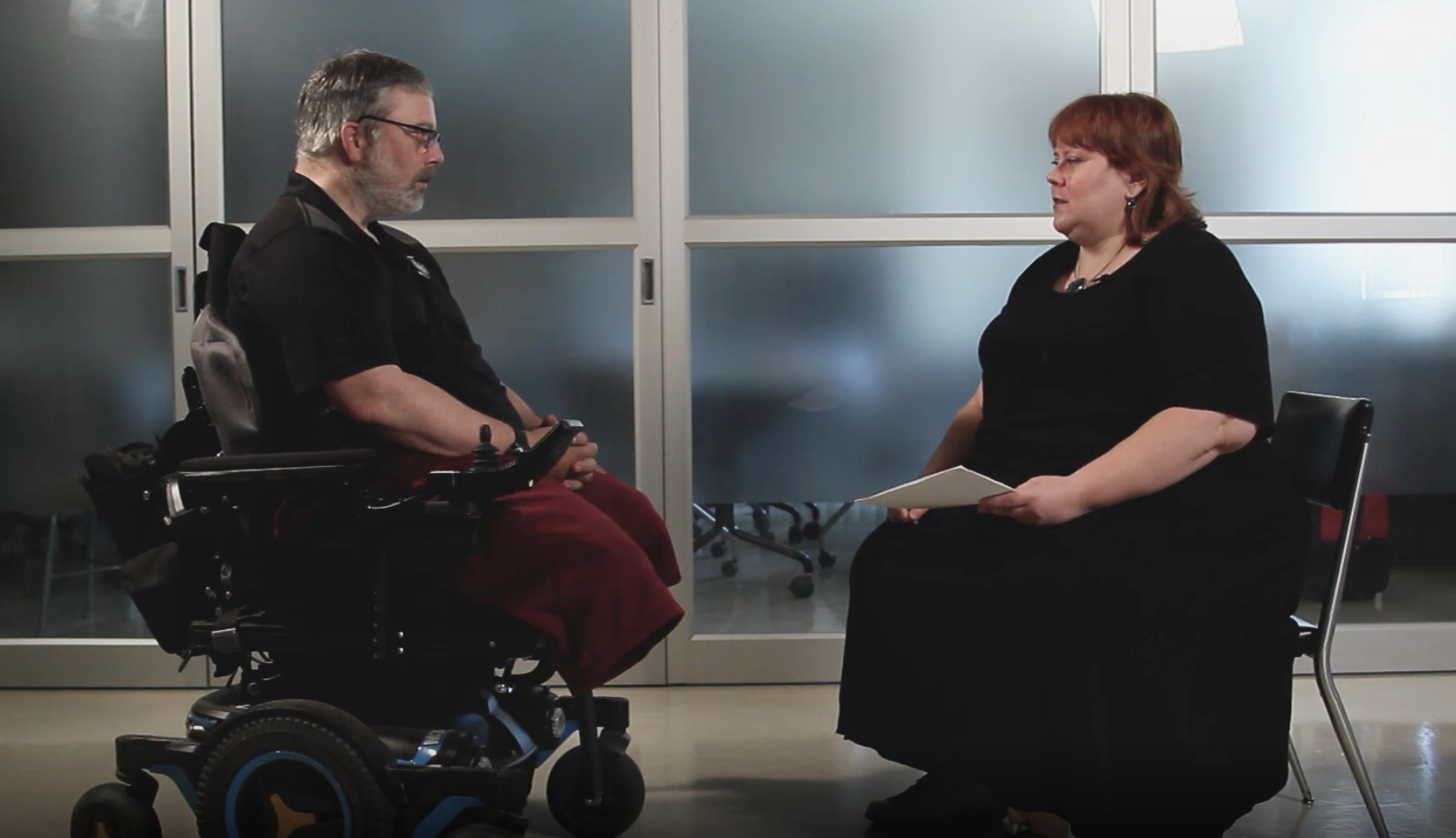Rx for a better ride: Quality of life starts with a well-fitting wheelchair
Therese Kehler - 21 January 2021

Occupational therapist Genevieve Jamin, right, demonstrates a client interview and seating assessment in a video case study for her online course for professionals.
When her client can “sit like a rock,” Genevieve Jamin knows the wheelchair is a perfect fit.
“It means they’re not sliding, they’re not leaning, they’re not having to reposition themselves every three minutes,” says Jamin, an occupational therapist who teaches Wheelchair and Seated Mobility — an online course offered by the University of Alberta Faculty of Rehabilitation Medicine’s Continuing Professional Education program.
Jamin is also clinic co-ordinator for the Edmonton Zone Seating Service, one of 19 Alberta Health Services teams that serve Albertans with specialized and complex wheelchair and seating needs.
“Often I talk about wheelchairs like a good-fitting pair of shoes. Just think of the ill-fitting pairs of shoes that you’ve had in your life and how terrible they are, what problems they cause. Now, imagine that being a wheelchair that you have to use for five to 10 years.”
There is an art, a science and a bit of mechanical know-how in fitting a chair to the unique needs of people for whom a wheelchair is necessary to live their daily life.
But up until a few years ago, there weren’t many therapists in Alberta with the expertise.
That’s now changing, thanks to the learning modules Jamin delivers to professional occupational and physical therapists through the Faculty of Rehabilitation Medicine.
Much of the course material is based on knowledge Jamin has picked up since 2007 when she began working as an occupational therapist in a long-term care centre for veterans. There she quickly learned what a well-fitting wheelchair could mean to someone’s life.
“I’ve seen people go from agitated and screaming to comfortably asleep in the course of an hour with the right wheelchair adjustments,” she says. A well-fitting wheelchair can provide relief to people with weak core muscles who struggle to stay upright or to paraplegics who experience chronic pain.
“I realized how inadequate my training was in terms of wheelchairs. … It basically consisted of ‘Take some measurements, put it into a little calculator, and this is the chair you get.’”
Jamin’s Wheelchair and Seated Mobility course teaches therapists to assess a client’s strength, balance, skin integrity and life goals to choose a chair and its modifications.
And there are plenty of modifications to choose from. There are backrests, headrests, cushions, bases and mounting brackets. Angles can be changed, heights adjusted. Each change might prevent wounds from forming, deformities from worsening, or help a client to sit up straighter, making it easier to swallow or look directly into the face of someone else.
Jamin’s first foray in teaching wheelchair seating came in 2013 when she started giving lectures to OT students at the U of A. A new generation of clinicians would graduate with these important skills, but there was still the matter of increasing public access to seating specialists.
With only a few seating clinics in the province at the time, there were long waiting times for assessment, Jamin says. Edmonton’s Glenrose Rehabilitation Hospital, for example, was the only clinic serving Albertans living between the capital city and the Northwest Territories, its clients often waiting 18 months or more to be seen.
In 2016, Alberta Health Services (AHS) approached the Department of Occupational Therapy to repurpose Jamin’s university class for allied health professionals, resulting in the seating course and a one-day client assessment workshop, both of which are available online.
“Having that knowledge and that process for doing your assessment correctly in the beginning really changes things,” says Amberlie Heaman, an AHS occupational therapist in Jasper, Alta., who took the course in its first year and recently opened a seating clinic to serve people in Jasper, Hinton, Edson, Mayerthorpe and Whitecourt.
Formerly, residents of these rural communities would have been on the long waitlist to see a seating specialist at the Glenrose. Now, they’re being assessed closer to home and getting their equipment in just a few months, Heaman says.
Since the U of A courses launched in 2017, more than 800 professionals have taken one or both.
Over the same period, the number of seating clinics in Alberta has increased from four to 19.
Heaman says increasing the base level of knowledge about wheelchair seating is making a world of difference. OTs in small hospitals, such as the ones in her clinic’s rural service area, are better able to identify clients who might benefit from different equipment or services.
But the final measurement of success always lies with the person who is using the chair, says Heaman, who calls that the other big takeaway from the course.
Jamin emphasizes to students the need to listen to a client’s goals, which could be “drag racing, panhandling, collecting bottles, stand-up comedy, berry picking” — things that definitely might not be what the therapist was thinking of as priorities.
To emphasize that the chair shouldn’t dictate a lifestyle, Jamin has a ready supply of success stories and anecdotes about clients and YouTube stars who are living full lives thanks to wheelchairs that have been configured with their goals in mind.
“Being in a wheelchair, it’s not the end of the world, it’s not death, it’s different,” she says.
“It’s a different way of rocking and rolling but it doesn’t mean your life’s over. What do you want to do? We can make that happen.”
Learn more and register in the Faculty of Rehabilitation Medicine’s Wheelchair and Seated Mobility course for professionals.